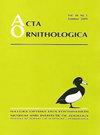Hypotarsus Morphology of the Ralloidea Supports a Clade Comprising Sarothrura and Mentocrex to the Exclusion of Canirallus
IF 1.3
4区 生物学
Q3 ORNITHOLOGY
引用次数: 5
Abstract
Molecular data suggest that the traditional Rallidae (rails) are polyphyletic and that some species actually belong to a clade that is the sister taxon of the Heliornithidae (sungrebes). This clade includes the African taxon Sarothrura and the Madagascan Mentocrex and has been termed Sarothruridae. It was noted that White-spotted Flufftail Sarothrura pulchra and Sungrebe Heliornis fulica share a distinctive morphology of the hypotarsus, which guides the tendons for the flexor muscles of the toes. Owing to the scarcity of skeletons in osteological collections, however, other species of the Sarothruridae and Heliornithidae have not yet been studied. Here, the hypotarsus of extant and fossil members of the Ralloidea is examined. It is shown that the characteristic hypotarsus morphology is also present in Buff-spotted Flufftail Sarothrura elegans (Sarothruridae), Madagascan Wood Rail Mentocrex kioloides (Sarothruridae), and African Finfoot Podica senegalensis (Heliornithidae). Grey-throated Rail Canirallus oculeus, by contrast, which was traditionally considered closely related to Sarothrura and Mentocrex, exhibits the hypotarsus morphology found in the Rallidae. To foster future communication, it is here proposed to use the taxon name Heliornithes for the clade including Heliornithidae, Sarothrura, and Mentocrex. A previously unknown derived hypotarsus morphology is described, which characterizes the rallid taxon Porphyrio (swamphens) and may be functionally correlated with the fact that the species of this taxon manipulate food items with their feet.小鹿总科的下跗骨形态支持一个包含Sarothrura和Mentocrex的分支,但不包括Canirallus
分子数据表明,传统的Rallidae(rails)是多系的,一些物种实际上属于Helornithidae(sungrebes)的姐妹分类单元。该分支包括非洲分类单元Sarothrura和马达加斯加曼托克里,被称为Sarothruridae。值得注意的是,白斑Flufftail Sarothrura pulchra和Sungrebe Helornis fulica有着独特的下丘脑形态,它引导脚趾屈肌的肌腱。然而,由于骨物学收藏中骨骼稀少,Sarothruridae和Helornithidae的其他物种尚未得到研究。在这里,对现存的和化石的拉罗总科成员的下丘脑进行了检查。结果表明,在Buff斑点Flufftail Sarothrura elegans(Sarothruridae)、Madagascan Wood Rail Mentocrex kioloides(Sarrotruridae。相比之下,传统上被认为与Sarothrura和Mentocrex亲缘关系密切的灰喉大椎,表现出在大椎科中发现的低屁股形态。为了促进未来的交流,这里建议使用分类单元名称Helornithes作为分支,包括Helornithidae、Sarothrura和Mentocrex。描述了一种以前未知的来源于下鳍的形态,它是平行分类单元Porphyrio(沼泽母鸡)的特征,并且可能与该分类单元的物种用脚操纵食物的事实在功能上相关。
本文章由计算机程序翻译,如有差异,请以英文原文为准。
求助全文
约1分钟内获得全文
求助全文
来源期刊

Acta Ornithologica
生物-鸟类学
CiteScore
2.10
自引率
0.00%
发文量
14
审稿时长
>12 weeks
期刊介绍:
Publishes scientific papers (original research reports, reviews, short notes, etc.) and announcements from all fields of ornithology. All manuscripts are peer-reviewed.
Established in 1933 as Acta Ornithologica Musei Zoologici Polonici, since 1953 continued under the present title.
Published twice a year by the Natura Optima Dux Foundation under the auspices of the Museum and Institute of Zoology, Polish Academy of Sciences.
 求助内容:
求助内容: 应助结果提醒方式:
应助结果提醒方式:


